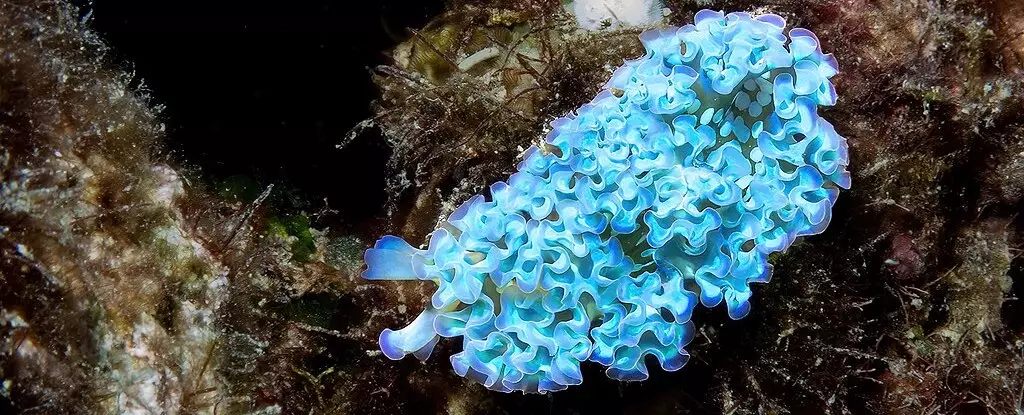At first glance, the lettuce sea slug might resemble an odd piece of an alien tableau, an unassuming mollusk that instantly captivates with its vivid colors and peculiar lifestyle. Upon closer examination, however, this creature epitomizes the remarkable ingenuity of evolutionary adaptation. Elysia crispata has mastered the art of theft—not from its fellow sea dwellers, but from the very algae it consumes. This remarkable ability allows it to repurpose components from its prey, demonstrating an extraordinary twist on the traditional concepts of survival and metabolic function in the animal kingdom.
What’s particularly breathtaking about the lettuce sea slug is its capacity to capture and integrate chloroplasts, the essential organelles responsible for photosynthesis in plants, into its own cellular framework. These photosynthesizing structures are not merely digested; instead, they are hoarded away in specialized sacs known as kleptosomes, where they can continue to function, harnessing sunlight to fuel the slug’s existence. It’s an unabashed example of biological piracy, yet it prompts us to reconsider what it means to be an organism in the natural world—not merely a borrower but a master of using the tools at one’s disposal.
Chloroplasts: The Unlikely Lifeline
The lettuce sea slug’s use of chloroplasts transcends basic energy acquisition; it is a vivid reflection of a sophisticated survival strategy. While the slug typically feeds on algae, its reliance on these captured organelles during periods of starvation reveals a deeper level of adaptation. Recent research indicates that these kleptosomes allow the chloroplasts to thrive and even merge with slug proteins, creating a seamless integration between the slug and its “stolen” treasures. This peculiar partnership raises compelling questions about the nature of symbiosis and the evolution of life in extreme conditions.
To many, the idea of “stealing” life-sustaining resources might seem morally questionable, yet nature often operates on a different wavelength. The concept of morality, particularly in the context of survival, varies significantly when considered from the vantage point of evolutionary success versus ethical implications. The lettuce sea slug serves as a vivid illustration of how survival often hinges not just on the acquisition of food, but the clever utilization of available resources—often through unconventional means. In an environment that demands constant adaptation, the slug has effectively become a savvy operator in the food web.
Colors of Adaptation
Moreover, the visual spectrum of the lettuce sea slug, which ranges from vibrant greens to oranges, reflects metabolic health and access to nutritional resources. The color changes in response to food scarcity illustrate the slug’s reliance on its chloroplasts not just for immediate sustenance, but also as a form of self-preservation. When food becomes scarce, the slug resorts to breaking down these chloroplasts, revealing another layer of complexity in how this organism navigates its ecological niche.
This nuance adds to the beauty of nature’s solutions; the lettuce sea slug is not simply relying on theft but is also a testament to the delicate balance of life. It pushes the boundaries of what we traditionally consider as effective biotic strategies. The sheer science of survival forces one to appreciate the intricate dance of predator and prey, as well as the layers of adaptation required to thrive.
The Bigger Picture: Revolutionary Biological Relationships
The implications of understanding the lettuce sea slug extend beyond mere biological curiosity. By studying such intricate evolutionary strategies, scientists might glean insights into broader biological phenomena, including how different organisms gain abilities beyond their normal capabilities. The slug’s ability to incorporate chloroplasts raises profound questions about the evolutionary pathways that led to cellular structures like mitochondria, previously believed to be purely products of a far-distant ancestral relationship.
This bustling little organism serves as both a biological marvel and an essential key to unraveling more complex questions regarding life’s adaptability. The understanding of these relationships, how organisms can commandeer essential functions from their environment, might even offer humbling lessons for humanity, prompting us to rethink how we interact with and learn from the ecosystems that underpin our existence.
In essence, the lettuce sea slug reminds us that the laws of nature often favor the ingenious, with survival hinged not simply on strength, but cunningness. It’s a call for both admiration and reflection as we continue to explore the depths of what survival truly means in the splendorously intricate web of life.


Leave a Reply